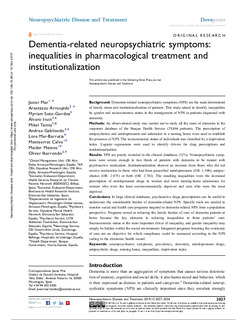| dc.rights.license | Attribution-NonCommercial-NoDerivatives 4.0 International | * |
| dc.contributor.author | Soto-Gordoa, Myriam | |
| dc.contributor.other | Mar Medina, Javier | |
| dc.contributor.other | Arrospide, Arantzazu | |
| dc.contributor.other | Iruin, Álvaro | |
| dc.contributor.other | Tainta, Mikel | |
| dc.contributor.other | Gabilondo, Andrea | |
| dc.contributor.other | Mar-Barrutia, Lore | |
| dc.contributor.other | Calvo, Montserrat | |
| dc.contributor.other | Ibarrondo Olagüenaga, Oliver | |
| dc.date.accessioned | 2019-11-15T16:01:12Z | |
| dc.date.available | 2019-11-15T16:01:12Z | |
| dc.date.issued | 2019 | |
| dc.identifier.issn | 1178-2021 online | en |
| dc.identifier.issn | 1176-6328 print | en |
| dc.identifier.other | https://katalogoa.mondragon.edu/janium-bin/janium_login_opac.pl?find&ficha_no=153442 | en |
| dc.identifier.uri | https://hdl.handle.net/20.500.11984/1501 | |
| dc.description.abstract | Background: Dementia-related neuropsychiatric symptoms (NPS) are the main determinant
of family stress and institutionalization of patients. This study aimed to identify inequalities
by gender and socioeconomic status in the management of NPS in patients diagnosed with
dementia.
Methods: An observational study was carried out to study all the cases of dementia in the
corporate database of the Basque Health Service (29,864 patients). The prescription of
antipsychotics and antidepressants and admission to a nursing home were used to establish
the presence of NPS. The socioeconomic status of individuals was classified by a deprivation
index. Logistic regressions were used to identify drivers for drug prescriptions and
institutionalization.
Results: NPS are poorly recorded in the clinical databases (12%). Neuropsychiatric symptoms
were severe enough in two thirds of patients with dementia to be treated with
psychoactive medication. Institutionalization showed an increase from those who did not
receive medication to those who had been prescribed antidepressants (OR: 1.546), antipsychotics
(OR: 2.075) or both (OR: 2.741). The resulting inequalities were the increased
prescription of antidepressant drugs in women and more nursing-home admissions for
women who were the least socioeconomically deprived and men who were the most
deprived.
Conclusions: In large clinical databases, psychoactive drugs prescriptions can be useful to
underscore the considerable burden of dementia-related NPS. Specific tools are needed to
monitor social and health care programs targeted to dementia-related NPS from a population
perspective. Programs aimed at reducing the family burden of care of dementia patients at
home become the key elements in reducing inequalities in these patients’ care.
Socioeconomic status is the most important driver of inequality, and gender inequality may
simply be hidden within the social environment. Integrated programs boosting the continuity
of care are an objective for which compliance could be measured according to the NPS
coding in the electronic health record. | en |
| dc.description.sponsorship | Gobierno Vasco | es |
| dc.language.iso | eng | en |
| dc.publisher | Dove Medical Press Limited | en |
| dc.publisher | prevalence | en |
| dc.rights | © Dove Medical Press Limited | en |
| dc.rights.uri | http://creativecommons.org/licenses/by-nc-nd/4.0/ | * |
| dc.subject | neuropsychiatric symptoms | en |
| dc.subject | dementia | en |
| dc.subject | antidepressant drugs | en |
| dc.subject | antipsychotic drugs | en |
| dc.subject | nursing home | en |
| dc.subject | inequalities | en |
| dc.subject | deprivation index | en |
| dc.title | Dementia related neuropsychiatric symptoms: inequalities in pharmacological treatment and institutionalization | en |
| dcterms.accessRights | http://purl.org/coar/access_right/c_abf2 | en |
| dcterms.source | Neuropsychiatric disease and treatment | en |
| local.contributor.group | Innovación, gestión, organización | es |
| local.description.peerreviewed | true | en |
| local.identifier.doi | https://doi.org/10.2147/NDT.S209008 | en |
| local.relation.projectID | BIOEF BIO12/AL/005 | en |
| local.relation.projectID | BIOEF BIOD17/ND/015 | en |
| local.rights.publicationfee | APC | en |
| local.rights.publicationfeeamount | 2270 EUR | en |
| local.contributor.otherinstitution | https://ror.org/02g7qcb42 | es |
| local.contributor.otherinstitution | https://ror.org/02g7qcb42 | es |
| local.contributor.otherinstitution | https://ror.org/041c71a74 | es |
| local.contributor.otherinstitution | https://ror.org/02g7qcb42 | es |
| local.contributor.otherinstitution | https://ror.org/00epner96 | es |
| local.contributor.otherinstitution | Gobierno Vasco. Departamento de Salud | es |
| local.contributor.otherinstitution | https://ror.org/02g7qcb42 | es |
| local.source.details | Vol.15. Pp. 2027-2034. November, 2019 | eu_ES |
| oaire.format.mimetype | application/pdf | |
| oaire.file | $DSPACE\assetstore | |
| oaire.resourceType | http://purl.org/coar/resource_type/c_6501 | en |
| oaire.version | http://purl.org/coar/version/c_970fb48d4fbd8a85 | en |








